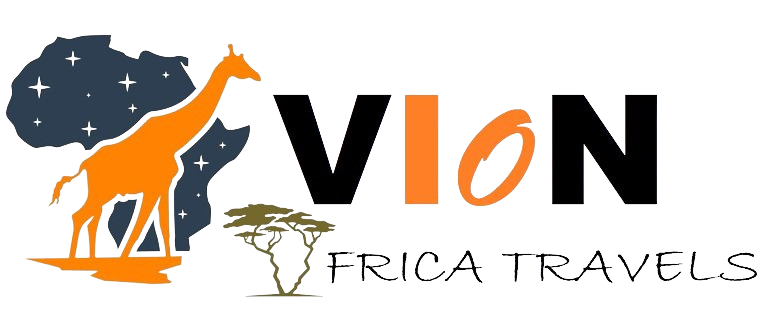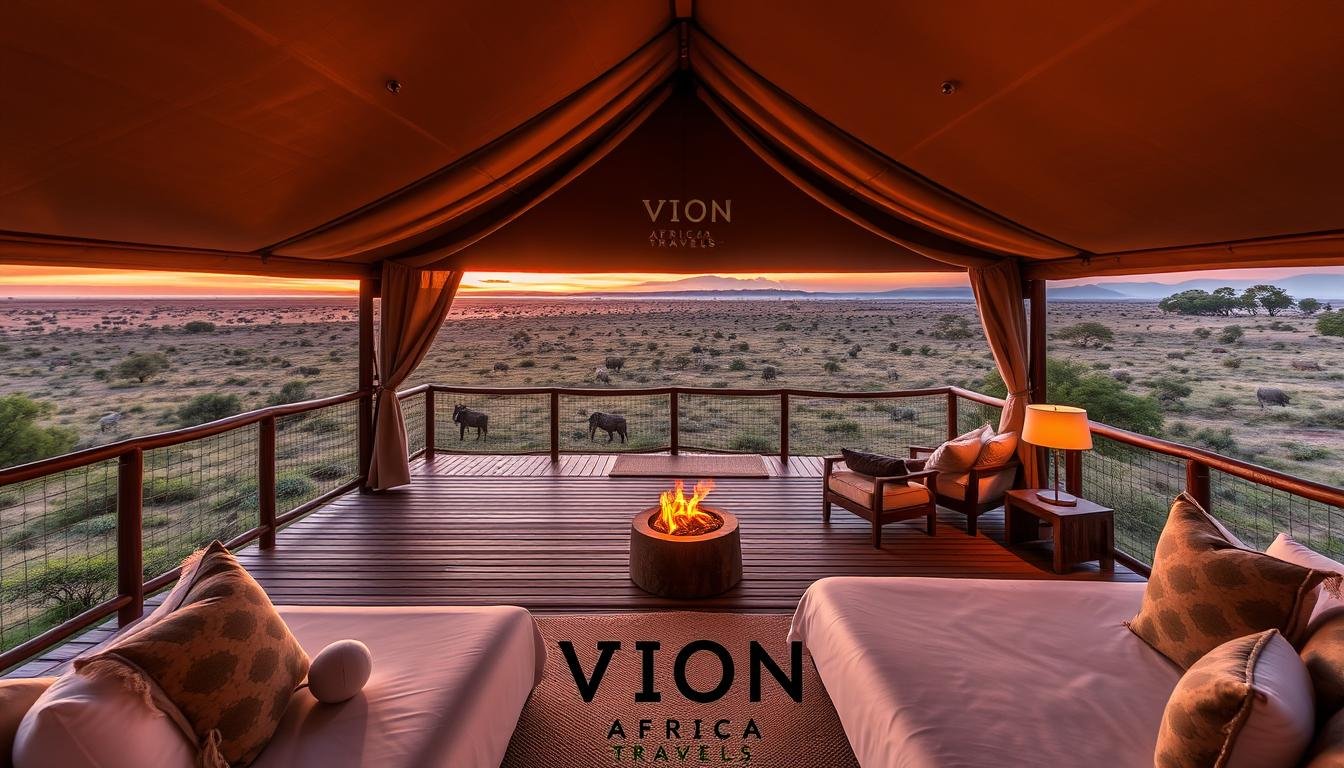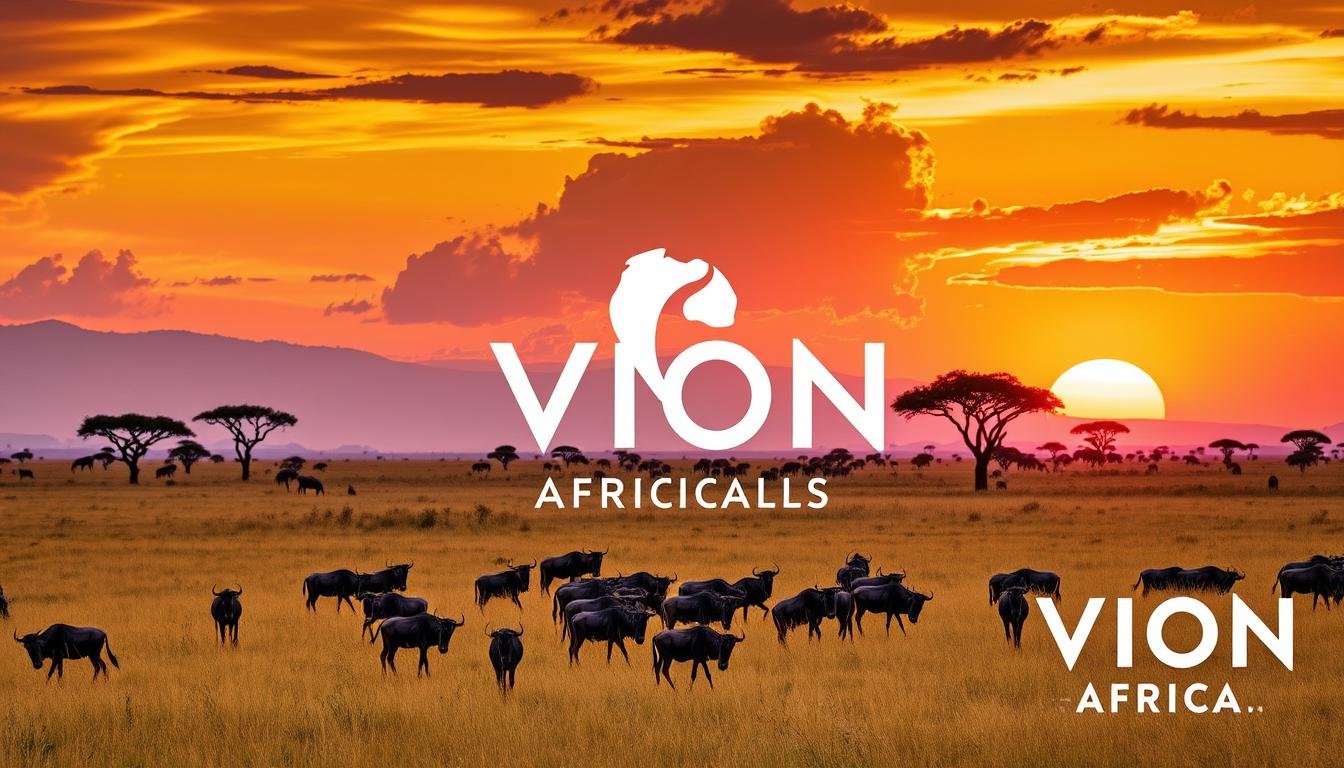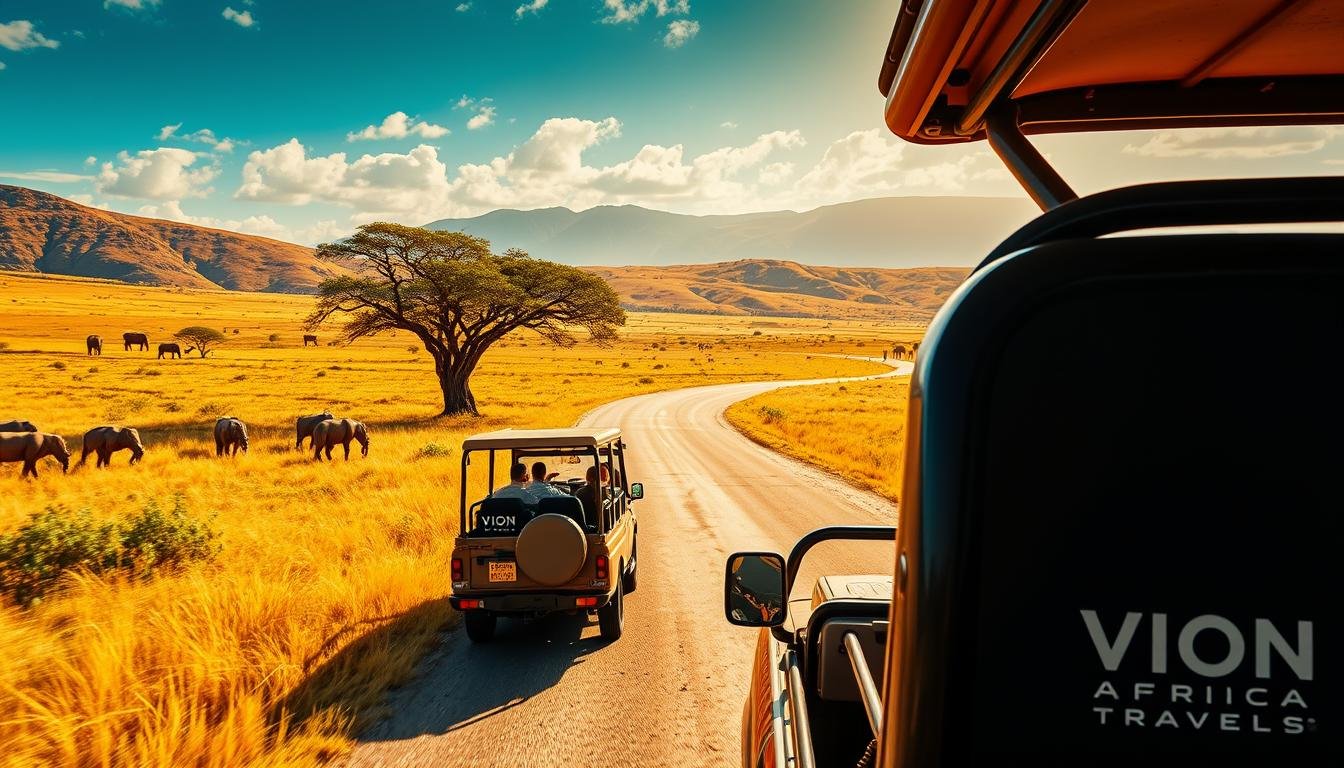Best time for Tanzania safari: Going on a Tanzania safari is a dream for many. It lets you see the amazing natural wonders and wildlife of Africa. When to go is key, with the Great Migration and dry and wet seasons to consider.
This guide will help you understand Tanzania’s safari seasons. We’ll talk about the best times for wildlife, unique sights, and what you need to know. Whether you want to see the Great Migration, enjoy the dry season, or the wet season, we’ve got you covered.
Key Takeaways
- Discover the ideal seasons for Tanzania safaris, from the Great Migration to the dry and wet seasons
- Explore the unique wildlife viewing opportunities and natural phenomena that occur throughout the year
- Gain insights into the logistical considerations, such as budget, accommodations, and guided experiences, to maximize your safari adventure
- Learn about the environmental and cultural aspects that shape the Tanzania safari experience
- Receive expert advice to plan your dream Tanzania safari, tailored to your preferences and travel goals
Understanding the Tanzania Safari Seasons
Exploring Tanzania’s diverse landscapes is thrilling. Knowing the seasonal changes is crucial for planning the perfect safari. Each season offers unique wildlife viewing and natural wonders.
The Great Migration Overview
The tanzania wildebeest migration is a natural wonder that attracts visitors worldwide. Millions of wildebeest, zebras, and other animals migrate across the Serengeti. This journey is a once-in-a-lifetime experience for many.
Dry Season vs. Wet Season
Tanzania has two main seasons: the tanzania safari dry season and the wet season. The dry season, from June to October, is great for wildlife viewing. Animals gather at water sources during this time.
The wet season, from November to May, offers lush landscapes and fewer crowds. It’s also a good time to see newborn animals.
Climate Considerations
The climate in Tanzania is warm and tropical. Temperatures range from the mid-70s to the low 90s Fahrenheit. Rainfall varies, with the north having a bimodal pattern and the south more consistent rain.
Knowing the climate helps plan safari activities and pack clothes.
| Season | Characteristics | Best for Wildlife Viewing |
|---|---|---|
| Dry Season (June – October) | Dry and hot, with limited rainfall | Excellent for spotting a variety of animals around water sources |
| Wet Season (November – May) | Lush, green landscapes, with increased rainfall | Ideal for witnessing the tanzania wildebeest migration and newborn animals |
Understanding each season helps plan a Tanzania safari. Travelers can choose the best time for their wildlife experiences and preferences.
The Best Months for Wildlife Viewing
Planning your Tanzania safari? Knowing the best months for wildlife viewing is key. Tanzania’s seasons offer unique chances to see amazing animals. Let’s dive into each season’s highlights and find the best times for your safari.
January to March: Calving Season
The calving season in Tanzania is exciting for wildlife lovers. You’ll see wildebeest, zebra, and more giving birth. It’s a crucial time for the next generation.
Witness newborns taking their first steps and bonding with their mothers. Predators like lions, leopards, and cheetahs are also around. This offers a glimpse into the ecosystem’s delicate balance.
April to June: The Rainy Season
The rainy season in Tanzania has its perks for wildlife viewing. The landscapes are lush, and water sources are full, attracting many animals. But, the rains can make some areas hard to reach.
Animals may be spread out, needing patience and skill from your guide to find them. Yet, the scenery is stunning, and the rains are refreshing.
July to October: Peak Safari Time
The tanzania safari peak season is when wildlife viewing is at its best. The tanzania safari dry season brings animals to water sources, making them easier to see. This is the best time to see the Serengeti’s Great Migration.
Millions of wildebeest and zebra move in search of food. With clear skies and perfect conditions, July to October is the perfect time for a Tanzania safari.
Tanzania’s wildlife is truly amazing, and local experts make your safari unforgettable. Knowing each season’s unique features helps plan your trip. This way, you can see Tanzania’s incredible natural wonders.
Special Events and Phenomena
Tanzania is famous for its amazing natural wonders. The tanzania wildebeest migration in the tanzania serengeti national park is a top event. It attracts people from all over to see one of the world’s greatest wildlife shows.
The Great Migration: March and April
When the rains stop and the Serengeti’s grasslands dry up, millions of wildebeests, zebras, and other animals start their journey. This journey peaks in March and April. During this time, they gather to cross the dangerous rivers.
The Wildebeest Crossing
The wildebeest crossing is a thrilling part of the tanzania wildebeest migration. The animals must cross rivers full of crocodiles in the tanzania serengeti national park. It’s a test of survival as they face the fast currents and crocodiles. Seeing this is a unique experience for any wildlife lover.
The timing of these events can change due to the rainy season’s unpredictability. But, safari experts like Altezza Travel team up with local guides. They make sure their guests see these wonders at their best.
| Event | Timing | Significance |
|---|---|---|
| The Great Migration | March and April | Massive herds of wildebeests, zebras, and other animals embark on an epic journey in search of fresh grazing lands. |
| Wildebeest Crossing | Varies, but often peaks in March and April | Herds must brave the treacherous river crossings, facing the threat of crocodiles and swift currents. |
Planning Your Safari Trip
Going on a Tanzania safari is an adventure you’ll never forget. But, it needs careful planning for a smooth and fun trip. You’ll need to think about your budget, choose the right safari, and book your stay.
Determining Your Budget
Your budget is key when planning your Tanzania safari. Prices vary based on the safari type, accommodation, and when you go. To save money, research different safari packages and their costs.
Choosing the Right Safari Type
Picking the right safari is important. Tanzania has many options, like game drives, walking safaris, and hot air balloon rides. Think about what you want to see and how adventurous you are to pick the best safari.
Booking Accommodations
Where you stay affects your safari experience. Tanzania has luxury lodges and budget-friendly tented camps. Look into the amenities, location, and reviews to find the perfect place for your safari.
Planning your Tanzania safari well ensures a memorable trip. Whether you want to see the Great Migration or enjoy a private game reserve, a well-planned safari creates lasting memories.
Family Safaris in Tanzania
Tanzania is a top spot for families wanting a memorable safari. It has diverse wildlife, beautiful landscapes, and a rich culture. Our guide will help you pick the best time and activities for a family-friendly safari in Tanzania.
Best Season for Family Trips
The dry season, from June to October, is the best time for a family safari in Tanzania. Wildlife gathers around water, making it easy to see many animals. The weather is also nice, with little rain, which is great for kids.
Many schools have holidays during this time, making it easy for families to travel together.
Child-Friendly Activities
- Game drives: These are fun and teach kids about wildlife. They can see animals like elephants and lions.
- Cultural experiences: Families can learn about the Maasai and Hadzabe communities. They can even join in cultural activities.
- Nature walks: Guided walks let families see birds, insects, and small animals up close.
- Educational programs: Safari lodges and camps have programs for kids. They teach about wildlife and conservation.
When planning your safari, think about your kids’ ages and interests. Talk to experienced tour operators to make sure your trip is safe and fun for everyone.
Photography Considerations
Capturing the breathtaking landscapes and mesmerizing wildlife of Tanzania’s Serengeti National Park requires careful planning. We must consider the optimal light conditions and timing. This ensures we get the most stunning shots during the Tanzania safari peak season.
Optimal Light Conditions
The golden hours around sunrise and sunset offer the best lighting for photography in the Serengeti. During these times, the sun casts a warm, soft glow. This enhances the colors and textures of the environment, creating a magical atmosphere. Midday sun can be harsh, casting harsh shadows and creating high-contrast scenes that can be challenging to capture.
Timing for Best Wildlife Shots
The Tanzania safari peak season, typically July through October, is the prime time for witnessing the dramatic Great Migration. To capture the best wildlife shots, it’s crucial to time your photography with the animals’ natural behaviors and activity levels.
- In the early morning and late afternoon, animals are most active as they graze, hunt, and move about the landscape.
- Midday is often the best time to photograph larger animals like elephants, giraffes, and lions, as they tend to rest and seek shade during the hottest hours.
- The wildebeest crossing of the Mara River is a thrilling spectacle, but it requires precise timing to capture the heart-pounding action.
By understanding the optimal light conditions and animal behaviors, we can plan our Tanzania safari photography. This maximizes our chances of capturing stunning, once-in-a-lifetime shots.
Cultural Experiences During Safaris
Going on a tanzania safari tour or package is more than seeing animals. It’s a chance to dive into Tanzania’s rich culture. We connect with local communities and celebrate their traditions.
Local Festivals and Events
Our safari might let us see local festivals and events. These celebrations show Tanzania’s diverse heritage. We see drumbeats, dances, colorful clothes, and stories. Attending these festivals helps us understand local customs and life.
Engaging with Indigenous Communities
Meeting indigenous communities is a highlight of a tanzania safari. We visit villages, learn about their traditions, and try activities like beadwork or cooking. These moments of cultural exchange give us a peek into their heritage.
When we explore cultural experiences on our safaris, we must be respectful. We should dress right, listen to our guides, and be mindful of local customs. This way, our visit can positively impact the communities we meet.
“Travel is fatal to prejudice, bigotry, and narrow-mindedness, and many of our people need it sorely on these accounts. Broad, wholesome, charitable views of men and things cannot be acquired by vegetating in one little corner of the earth all one’s lifetime.” – Mark Twain
By embracing the cultural side of a tanzania safari, we make unforgettable memories. We also help keep alive the traditions that make Tanzania special.
Choosing the Right National Park
Planning a Tanzania safari can be tough. Each park offers a unique wildlife experience. We’ll look at the Serengeti, Ngorongoro Crater, and Tarangire National Park to help you choose.
Serengeti National Park
The Serengeti National Park is Tanzania’s top safari spot. It’s famous for its vast grasslands and the wildebeest migration. You’ll see lions, leopards, elephants, and more here.
The best time to see the Serengeti’s wildlife is from July to October. This is when the wildebeest migrate.
Ngorongoro Crater
The Ngorongoro Conservation Area is home to the Ngorongoro Crater. This collapsed volcano is a natural wonder. It’s full of wildlife, including black rhinos.
The crater’s green floor is great for game viewing. It’s accessible all year. You can also learn about the Maasai culture nearby.
Tarangire National Park
Tarangire National Park is often missed. But it’s a hidden gem. In the dry season, it’s full of elephants.
The park’s diverse landscapes, like the baobab trees, make it special. Visit from June to October to see wildlife around the Tarangire River.
Your choice of park depends on what you want to see. Whether it’s the Serengeti, Ngorongoro, or Tarangire, Tanzania’s parks offer amazing wildlife adventures.
Preparing for Your Safari Adventure
Planning a Tanzania safari requires careful preparation for a smooth and fun trip. Whether you’re going during the tanzania safari dry season or the tanzania safari peak season, there are key things to remember.
Recommended Gear for Different Seasons
Choosing the right gear is crucial for your safari. In the dry season, wear light, breathable clothes to stay cool. Don’t forget sun protection like hats, sunglasses, and sunscreen. For the wet season, bring rain gear and sturdy shoes for muddy paths.
- Lightweight, breathable clothing for the dry season
- Sun protection (hats, sunglasses, sunscreen)
- Rain-resistant gear for the wet season
- Sturdy, closed-toe shoes
Health and Safety Tips
Your health and safety are top priorities on a Tanzania safari. Talk to your doctor about needed vaccinations and malaria prevention. Bring your medications and drink plenty of water and rest well during your safari.
- Consult your healthcare provider about recommended vaccinations
- Take preventative measures against malaria
- Pack necessary medications
- Stay hydrated and well-rested during your safari
By preparing well, you’re set for an amazing Tanzania safari, any time of year.
| Gear for Dry Season | Gear for Wet Season |
|---|---|
| Lightweight, breathable clothing | Rain-resistant outerwear |
| Sun protection (hats, sunglasses, sunscreen) | Sturdy, closed-toe shoes |
The Role of Local Guides
When planning your tanzania safari tours or tanzania safari packages, the role of local guides is crucial. They are the key to unlocking the magic of a safari in Tanzania.
Importance of Experienced Guides
Local guides know the terrain, wildlife, and culture well. Their skills in finding animals, navigating roads, and understanding wildlife behavior are vital. They help you see the most elusive and fascinating species.
How to Choose a Reliable Guide
- Choose guides with lots of experience in Tanzania’s national parks and reserves.
- Make sure your guide is licensed and certified. This shows they are professional and knowledgeable.
- Read reviews and ask for recommendations from others who have gone on safaris.
- Check if your guide speaks your language well. Good communication is key for a great safari.
Working with a skilled and reliable local guide makes your tanzania safari tour or tanzania safari package unforgettable. You’ll have amazing wildlife encounters and learn about the culture.
“The knowledge and expertise of our local guide made all the difference in our safari experience. We were able to spot the most elusive animals and gain a deeper understanding of the Tanzanian ecosystem.”
– John Doe, Seasoned Safari Traveler
Environmental Considerations
When planning a Tanzania safari, it’s key to think about the environment. The region’s wildlife and ecosystems are shaped by many factors. Knowing these can help us have a memorable and eco-friendly safari.
Ecotourism in Tanzania
Tanzania is a top spot for ecotourism. It focuses on travel that’s good for the planet and helps local people. Many eco-lodges and safari companies follow green practices. They make sure tourism helps the wildlife and the community.
Impact of Seasonal Changes on Wildlife
The tanzania safari dry season and the tanzania wildebeest migration show how seasons affect wildlife. In the dry season, animals gather near water, making them easier to see. The rainy season brings the wildebeest migration, a breathtaking sight.
| Season | Impact on Wildlife |
|---|---|
| Dry Season | Animals congregate around water sources, making them more visible for safari-goers. |
| Rainy Season | Wildebeest migration, a stunning natural phenomenon, takes place. |
Knowing about these environmental factors helps us choose the best time for a Tanzania safari. We can enjoy the wildlife while being kind to the ecosystem.
What to Expect on a Safari
Going on a Tanzania safari is an amazing adventure. It gives you a close look at the natural world’s wonders. Knowing about safari vehicles and itineraries is key. It helps you enjoy your tanzania safari tours and packages more.
Types of Safari Vehicles
The type of safari vehicle affects your experience. In Tanzania, you’ll find a few main types:
- Open-air safari vehicles: These sturdy 4x4s offer a full view of the landscape and animals.
- Pop-up roof vehicles: These have a roof that opens, letting you stand and see animals from above.
- Customized safari minivans: These are great for small groups or families, offering a cozy safari experience.
Typical Safari Itinerary
A typical safari day varies, but usually includes:
- Early morning game drive: Start as the sun rises, when animals are most active.
- Return to camp for breakfast: Enjoy a meal and rest before the next adventure.
- Midday activity: You might go on a walking safari, visit a village, or explore a cultural site.
- Afternoon game drive: See more animals and watch their behavior as the day cools.
- Sunset and evening: Enjoy the African sunset, then a big dinner and maybe a nighttime safari.
The itinerary can change based on your safari package, the season, and the operator’s preferences.
No matter the details, a Tanzania safari is unforgettable. It will make you appreciate the natural wonders of this amazing place even more.
Travel Logistics
Planning a Tanzania safari needs careful thought about travel logistics. You must pick the right airports and choose how to get around the country. These steps help make your safari smooth and enjoyable.
Best Airports for Access
For easy access to Tanzania’s top safari spots, a few airports are best. The Julius Nyerere International Airport in Dar es Salaam is a major hub. It’s the main entry for many tanzania safari tours and tanzania safari packages. The Kilimanjaro International Airport is another key spot, near Mount Kilimanjaro. It’s great for those heading to the northern safari circuit.
Transportation Options in Tanzania
After arriving, getting around to different safari spots is key. Domestic flights are a top choice, with Air Tanzania and Precision Air flying to many parks and reserves. For a scenic trip, private car transfers or chartered vehicles are available. They let you enjoy the beautiful views on the way.
| Transportation Option | Advantages | Considerations |
|---|---|---|
| Domestic Flights |
|
|
| Private Road Transfers |
|
|
By planning your arrival and travel in Tanzania well, you’ll have a great tanzania safari tours and tanzania safari packages experience.
The Cost of a Tanzania Safari
Planning a Tanzania safari is an exciting adventure. But, it’s key to know what affects the cost. The season, location, and luxury level all play a part. Let’s look at what to consider when budgeting for your Tanzania safari.
Factors Affecting Safari Prices
The cost of a Tanzania safari changes based on several things:
- Time of year: Prices go up in peak season, from July to October, when the wildebeest migrate.
- Type of accommodation: Luxury lodges and tented camps cost more than budget options.
- Duration of the safari: Longer safaris, 7-10 days, are pricier than shorter ones.
- Number of people in your group: Bigger groups might get better deals on tanzania safari packages.
- Transport method: Flying to remote spots is more expensive but saves time.
Budget vs. Luxury Safari Options
There’s a wide range of tanzania safari prices for different budgets:
| Budget Safari | Luxury Safari |
|---|---|
|
|
The cost of your Tanzania safari depends on your preferences and budget. Knowing these factors helps you choose the right tanzania safari accommodation for you.
Frequently Asked Questions
Planning your Tanzania safari? You might wonder about the best time to visit and safety during different seasons. We’re here to help with expert advice and answers to your key questions. This will help you make a smart choice for your trip.
Common Queries about Safari Timing
Many ask, “When is the best time for a Tanzania safari?” The answer varies based on what you want to see. The peak safari season is from July to October. This is when the Great Migration is at its peak, and the weather is cooler and drier.
However, the calving season from January to March is also great. You can see the birth of wildebeest and other animals.
Another question is, “What’s the difference between the dry season and the wet season in Tanzania?” The dry season, from June to October, is best for seeing animals. They gather at water sources because of the dry land.
The wet season, from November to May, is a bit harder. But it’s also when the land is green and migratory birds arrive.
Safety Concerns During Different Seasons
- In the dry season, staying hydrated and protected from the sun is key. Dehydration and heat sickness are risks.
- The wet season brings heavy rains. This can make roads bad and some areas hard to reach. Plan well and pack right.
- Always listen to your guide and follow park rules. This keeps you safe no matter the season.
Knowing what each season offers helps you choose the best time for your safari. You can then prepare for a safe and fun trip.
| Season | Best Time for… | Potential Challenges |
|---|---|---|
| Dry Season (June – October) |
|
|
| Wet Season (November – May) |
|
|
The best time for your Tanzania safari depends on what you want to see and do. Think about the seasons and safety to plan a memorable and safe trip.
Conclusion: Making the Most of Our Safari Experience
Reflecting on our journey through Tanzania’s landscapes, we feel awe and gratitude. We saw the Great Migration and met diverse wildlife. Our safari has deeply touched our hearts and minds.
Building Amazing Memories
Choosing the right time for our safari was key. We planned to see wildlife at its best. The calving season and wildebeest crossing made our trip unforgettable.
Final Tips for Travelers
As we say goodbye, we urge travelers to be adventurous and curious. Respect the ecosystem and plan well. This way, they can make lasting memories and help preserve Tanzania.
Whether it’s a family trip or a photography adventure, Tanzania’s safari awaits. The best time is now, waiting for you to discover it.



